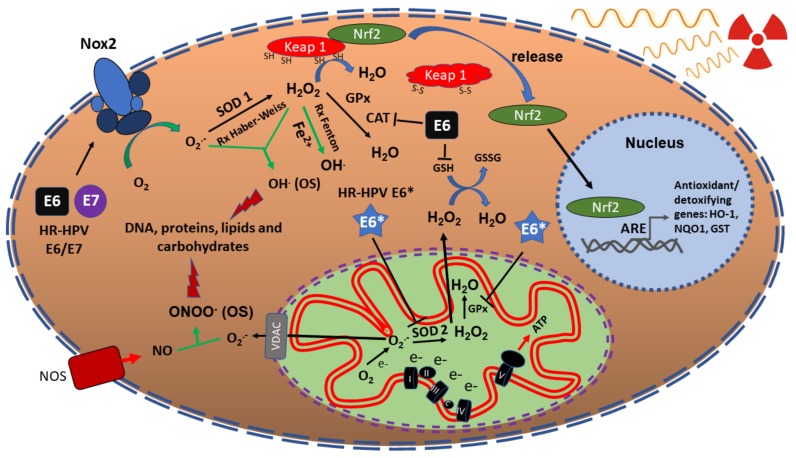Figure 1.
Redox state in irradiated HNSCC cells and the effect of HPV oncoproteins. HNSCC cells regulate oxidative stress induced by IR through the overexpression of Nrf2, which in turn activates genes such as catalase, superoxide dismutase (SOD2) and glutathione peroxidase (GPx), associated to antioxidant processes. On the other hand, the HR-HPV E6 protein induce OS, which decreases the GSH/GSSG rate, the levels of catalase and its activity [44]. E6* decreases SOD2 and GPx, provoking OS and consequently, DNA damage [45]. E6/E7 activate Nox2, inducing OS and DNA damage [46]. Therefore, altogether, HPV oncoproteins could sensitize HNSCC cells to radiation therapy. Nicotinamide adenine dinucleotide phosphate (NADPH) oxidase 2 (Nox2), superoxide dismutase (SOD), heme oxygenase (HO-1), NAD(P)H:quinone oxidoreductase 1 (NQO1), glutathione S-transferase (GST), glutathione peroxidase (GPx), catalase (CAT), glutathione (GSH), glutathione disulfide (GSSG), voltage-dependent anion channels (VDAC), peroxynitrite (ONOO−), nitric oxide (NO), superoxide anion (O2.−), hydrogen peroxide (H2O2), hydroxyl radical (OH.), high-risk human Papillomavirus (HR-HPV), nuclear factor (erythroid-derived 2)-like 2 (Nrf2), antioxidant response elements (ARE), nitric oxide synthase (NOS). The red rays indicate the damage to DNA, protein, carbohydrates and lipids.

